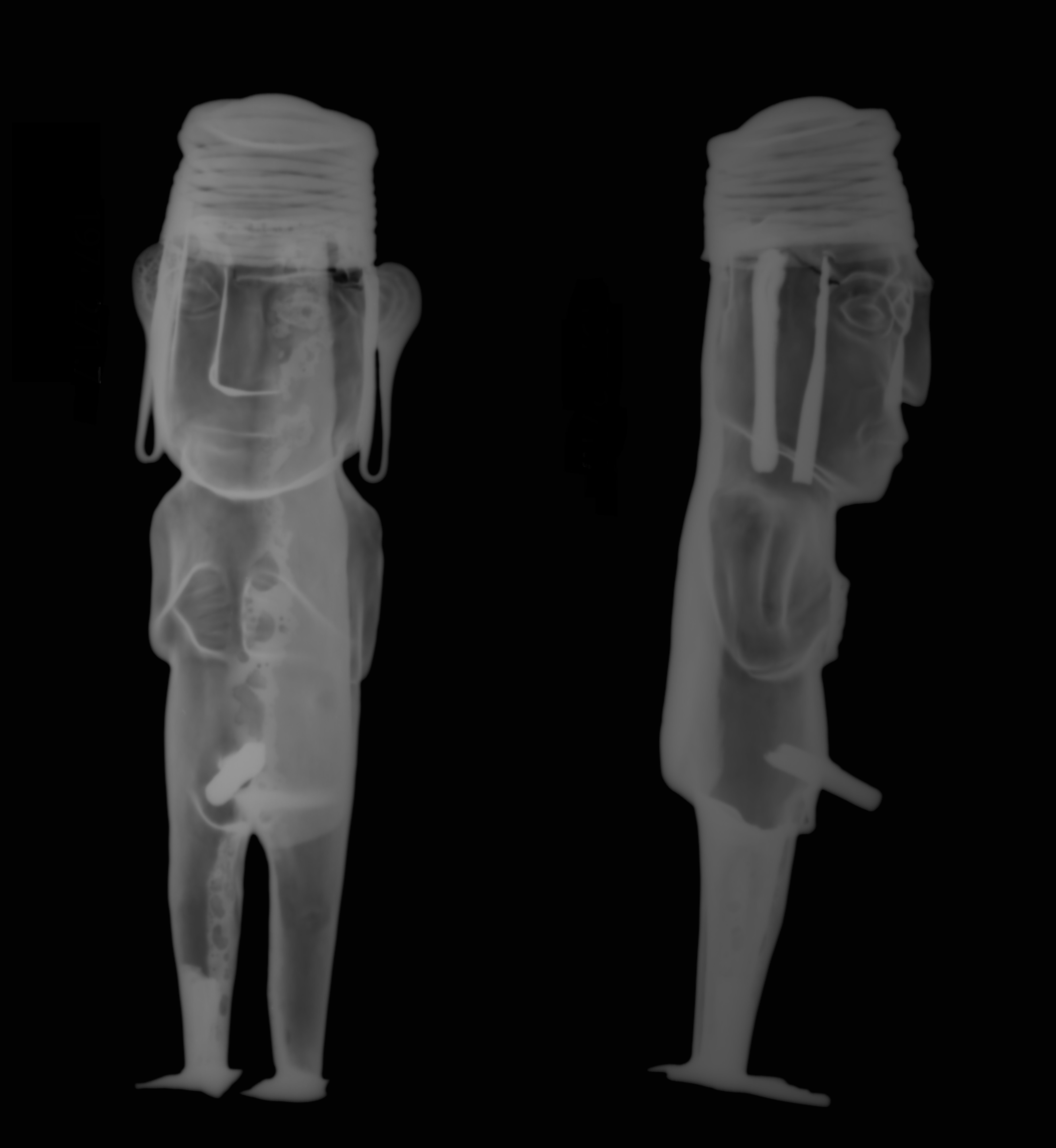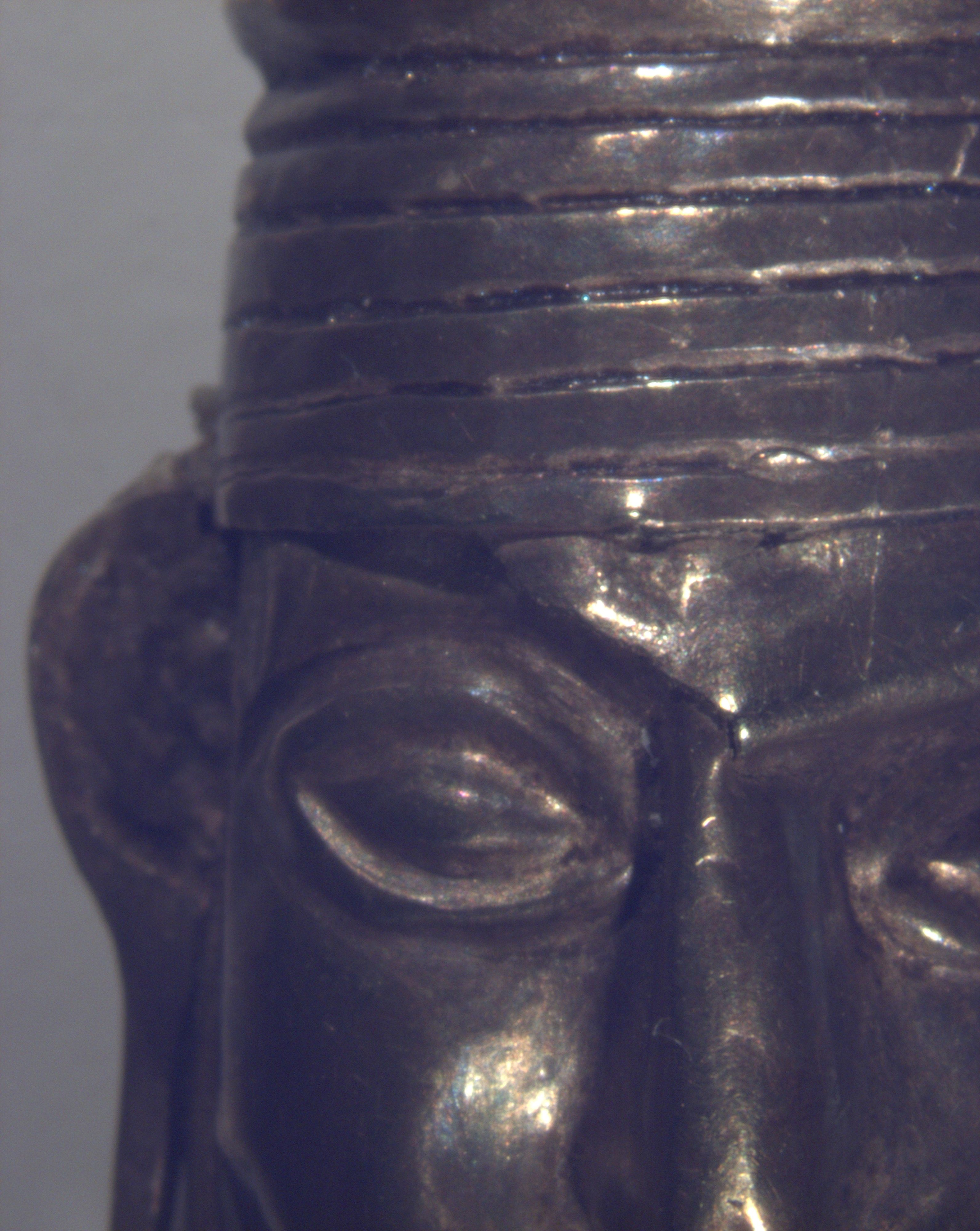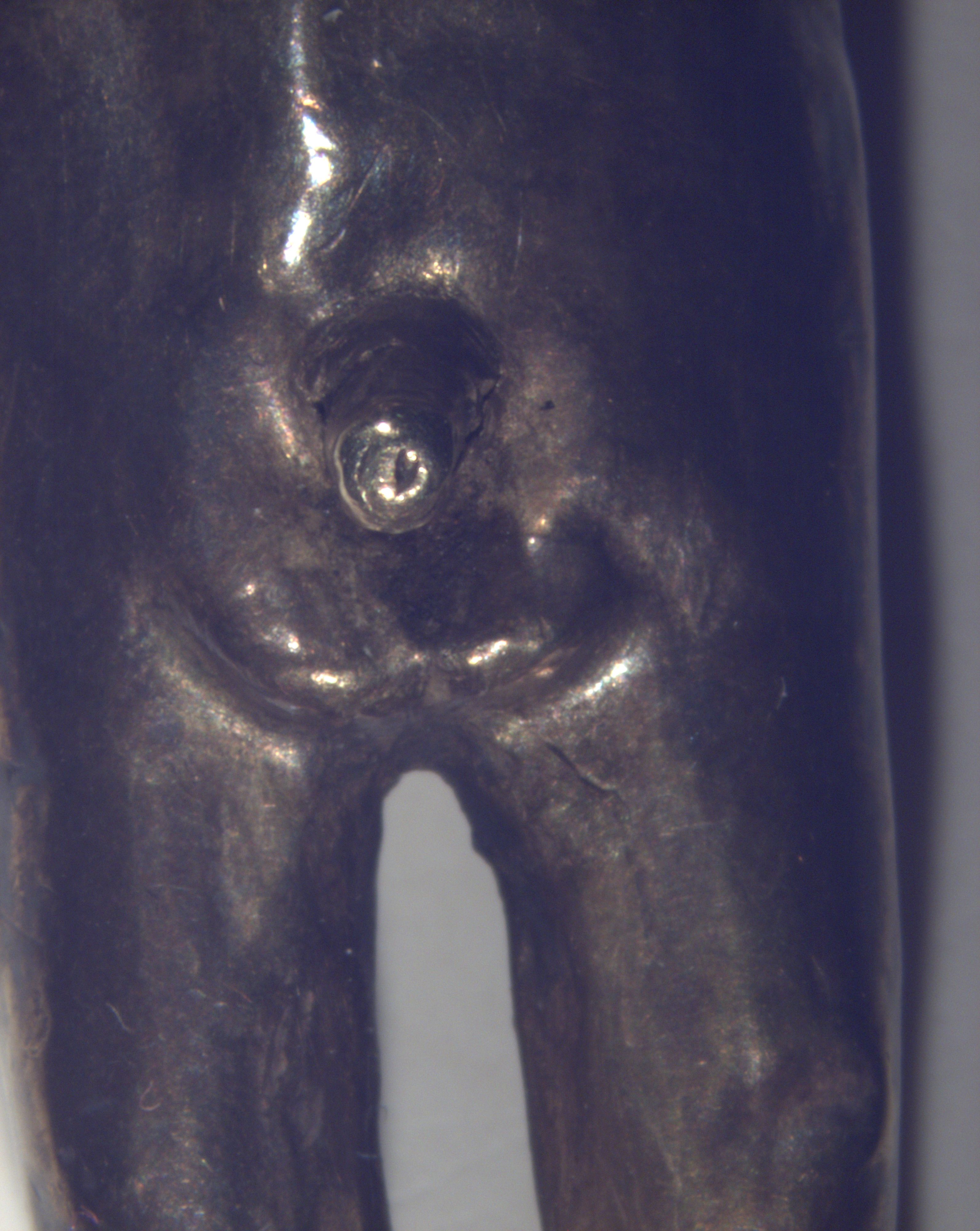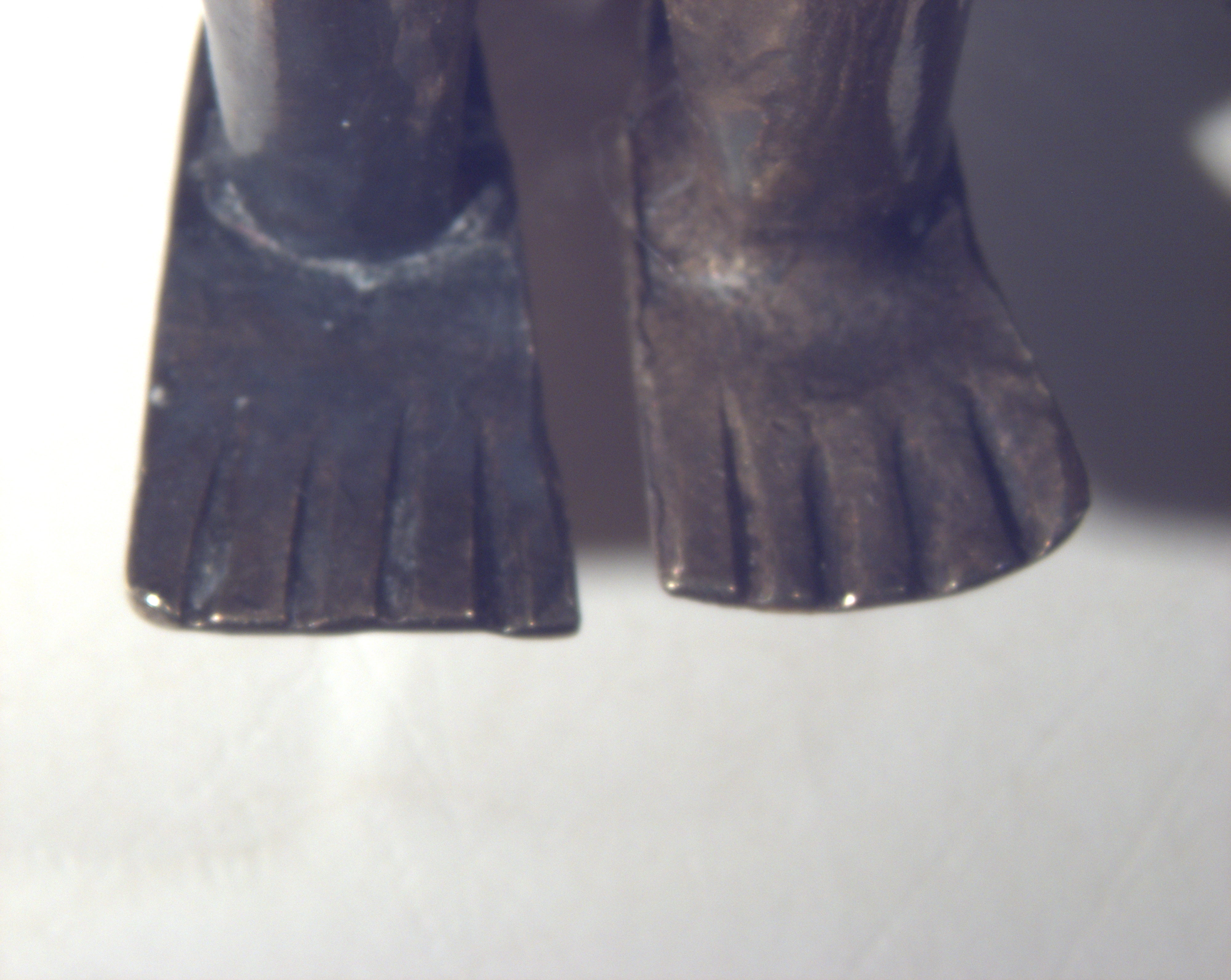Miniature male effigy
This figurine depicts a man wearing a llautu, an Inca headdress often made of camelid wool, who is otherwise naked. The almond-shaped eyes, nose, and mouth, along with the ears with extended lobes that suggest they were fitted with spools and a small raised region on the proper left of mouth, indicating that the person depicted is actively chewing coca, a sacred plant whose consumption helps to fortify relationships among Andean peoples to the natural world and with each other (Allen 2002). The male figure stands upright with arms and hands brought in close to the chest.
The figurine was likely fabricated and deposited as a huaca, a Quechua and Aymara term for a sacred being, and may have been part of a wider Inca offering to a huaca. One such type of offering was the Inca imperial practice of capac hucha, or royal obligation, involving the collection of materials and human beings to be offered in Cusco and their sacrifice there, in the Inca imperial center, or in provincial regions as a way of marking the geographical extent of the empire (Cieza de León 1959, 190-193; Diez de Betanzos 1996, 46).
There tend to be three height groups (5-7 cm, 13-15 cm, 22-24 cm) among this corpus of Inca anthropomorphic figurines in metal (see McEwan 2015, 282, n. 15), and this figurine is in the smallest height group. The figurine was fabricated by joining seven pieces of metal sheet together, whose composition is approximately 53% gold, 40% silver, and a small amount of copper, by XRF. It may have once been wrapped in textiles, including an uncu (tunic) and a yaqolla (mantle), adorned with feathers on its head, and woven fibers, in the form of a llautu, wrapped around the metal version of this headdress (see MAAM 2007, 72 for examples of such figurines from the capac hucha assemblage from Llullaillaco).
As the x-rays indicate (see image 2), the seven sheet components of the object include: the llautu, or headdress; the head, torso, and legs; the two ears; the penis; a gusset in the crotch region; and the two feet. The metalsmith hammered rectangular sheet, wrapping it around to form the cylindrical shape of the llautu body and raising it to form the hemispherical cap of the llautu from the same piece of metal. Any seam that would have resulted from joining the two vertical lengths of this semi-cylinder is not apparent (contra. Dumbarton Oaks PC.B.474 in Lechtman 1996, 309). The llautu is engraved with horizontal lines extending around the cylinder (see image 3), in a way creating the wraps of woven camelid fiber that may have encircled the head or providing the base for an external layer of Spondylus shell decoration, as included on male figurines from Llullaillaco and Choquepujio respectively.
The ears, elongated to show that they could accommodate spools, a marker of Inca nobility, were hammered to shape and joined to the sides of the head likely by soldering, as Lechtman (1996, 309) observed for DO PC.B.474. The body of the llautu overlaps the top edges of the head (see image 3). In the process of joining these components, some irregularities emerged in the head region, including an overlap of metal on the proper right forehead immediately underneath the headdress.
The details on the face have been hammered from the interior and/or exterior, including the indication of a quid of coca in the mouth, shown by a slight indentation on the proper left side of the lip. Like the semi-cylindrical headdress piece, the head/torso/legs piece was also joined at its ends, though along its major axis in this case, and a seam is visible down the back of the figurine, slightly right of center. It appears that the left end of this torso region overlaps the right end, and the two ends were soldered, given the presence of porosity and partial discoloration, suggesting a different metal composition, in this region. The individual fingers on the hands have been indicated by fine hammering from what is now the interior of this sheet.
The penis is a separate sheet component (see image 4). The metalsmith perforated the head/torso/legs piece in the region of the penis. The metal in this location is no longer present, except for the upper portion which is attached at the top. The penis is made of a hammered tube of metal that was attached by soldering to the top of this perforated region. The profile x-ray shows that it extends into the figurine. The testicles have been indicated by hammering the head/torso/legs sheet. Seams are also present on the legs; in both cases, the seam is on the inside-facing part of the leg and thus less conspicuous to the viewer. From macroscopic observation and x-radiography, it appears that solder was used to join the two vertical lengths of the cylinder that formed each leg. There is a slight discontinuity visible below the testicles suggesting that a gusset of metal has been added in the region to fill the space that would have remained open once the head/torso/legs component was in place. The feet are individual sheets hammered to shape that may have extension on the tops and that were inserted into the leg components. The smith has indicated toes by engraving the top of each foot piece (see image 5).
This figurine and others in the corpus of Inca figurines of metal emerged out of a long tradition in the central Andes of the plastic deformation of metal and the joining of multiple pieces of sheet. The location of their production is uncertain, but, in terms of their deposition, many of these figurines were specially curated to play an efficacious role, as huacas themselves, in larger assemblages of metal, Spondylus, and textiles at key sacred sites throughout the Inca landscape.
Technical notes: Optical microscopy, X-radiography, and XRF conducted in 2017.
Bryan Cockrell, Curatorial Fellow, AAOA
Beth Edelstein, Associate Conservator, OCD
Ellen Howe, Conservator Emerita, OCD
2017
Published References
Burger, Richard L., and Lucy C. Salazar. Machu Picchu: Unveiling the Mystery of the Incas. New Haven: Yale University Press, 2004, cat. no. 166.
Further Reading
Allen, Catherine J. The Hold Life Has: Coca and Cultural Identity in an Andean Community. Washington, D.C.: Smithsonian Institution Press, 2002.
Cieza de León, Pedro de. The Incas. Edited by Victor Wolfgang von Hagen. Translated by Harriet de Onis. Norman: University of Oklahoma Press, [1553] 1959.
Diez de Betanzos, Juan. Narrative of the Incas. Translated and edited by Roland Hamilton and Dana Buchanan. Austin: University of Texas Press, [1551-57] 1996.
Lechtman, Heather. “Technical Descriptions.” In Andean Art at Dumbarton Oaks, edited by Elizabeth Hill Boone. Washington, D.C.: Dumbarton Oaks Research Library and Collection, 1996.
McEwan, Colin. "Ordering the Sacred and Recreating Cuzco," in The Archaeology of Wak'as: Explorations of the Sacred in the Pre-Columbian Andes, edited by Tamara L. Bray, 265-291. Boulder: University Press of Colorado, 2015.
Museo de Arqueología de Alta Montaña (MAAM). Museo de Arqueología de Alta Montaña. Buenos Aires: Fondo Nacional de las Artes, 2007.
Scott, David A. “The Deterioration of Gold Alloys and Some Aspects of Their Conservation.” Studies in Conservation 28, no. 4 (1983), 194-203.
This image cannot be enlarged, viewed at full screen, or downloaded.
This artwork is meant to be viewed from right to left. Scroll left to view more.






